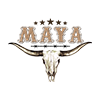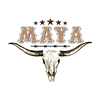DTF Transfers Niche Playbook: Build Profitable Subculture Apparel Lines with UV DTF, Blank T‑Shirts, Hoodies, Hats, Embroidery & Dropshipping
Launch a profitable subculture apparel brand with lower risk, high creative freedom, and scalable fulfillment. This deeply practical guide covers DTF transfers, UV DTF advantages, blank t-shirts, hoodies, hats, embroidery pairings, print-on-demand (POD) dropshipping, pricing, marketing, and the exact operational steps you need—whether you're an Etsy seller, Shopify entrepreneur, or a small apparel brand. MAYA TX-specific services (same-day pickup in Austin, nationwide shipping, dropshipping fulfillment, and wide blank apparel selection) are integrated throughout as concrete options to accelerate your launch.
Why DTF Transfers Are Ideal for Subculture Apparel
Direct-to-Film (DTF) transfers produce full-color prints on a PET film that are heat-pressed onto garments. For niche or subculture lines—where distinct aesthetics, small runs, and frequent iteration matter—DTF is especially useful:
- High color accuracy and smooth gradients for vintage, psychedelic, or highly detailed art.
- Works across multiple substrates (100% cotton, blends, polyester), making it easier to expand SKUs from hoodies to hats and bags.
- Low setup costs vs screen printing—great for testing new designs and limited drops.
- Fast turnaround when combined with UV DTF and optimized curing processes.
Use keywords throughout your listings and content: DTF transfers, UV DTF, custom apparel, blank t-shirts, hoodies, hats, embroidery, print-on-demand, dropshipping.
What UV DTF Adds: Speed, Durability, Consistency
UV-enhanced DTF workflows use UV-curable inks or UV finishing to accelerate drying and increase color stability. Consider UV DTF when:
- You need quicker curing for same-day or next-day fulfilment.
- You're printing on synthetic fabrics that hold inks differently (UV helps with adhesion and stability).
- Your brand promises consistent color across batches and seasonal restocks.
UV DTF can reduce rejects and reprints—vital for dropshipping where turnaround and quality directly affect customer satisfaction.
Blank Apparel: Choosing T‑Shirts, Hoodies & Hats That Sell
Blank selection shapes your product-market fit. For subculture markets, fabric hand-feel, fit, and details (taped seams, tear-away tags) influence brand perception:
- Blank T‑Shirts: Ringspun cotton (soft hand), 100% cotton for vintage prints, poly blends for performance and streetwear vibes.
- Hoodies: Midweight fleece (8–12 oz) for quality feel; heavy fleece for premium positioning; consider drop shoulder and oversized fits for certain niches.
- Hats: Dad caps and beanies for casual/core niches; structured snapbacks and trucker hats for skate and music communities. Embroidery is often preferred for hats; DTF can be used for panel prints or patches.
MAYA TX stocks a wide selection of blank apparel to quickly test fits and fabrications—see the Blank Apparel catalog at txmaya.com/blank-apparel.
Design Directions & Niche Examples to Validate
Test multiple aesthetics before scaling. Subculture niches are visual and community-driven—here are starter concepts that convert:
- Music scenes (punk, metal, indie): distressed band-style graphics, tour-list backs, grayscale + accent color palettes.
- Skate & streetwear: small chest logos, oversized silhouettes, logo slaps on sleeve hems.
- Vaporwave & synthwave: neon gradients, 80s/90s iconography, full-bleed back prints.
- Cottagecore & slow fashion: hand-inked florals, muted tones, chest-sized botanical prints.
Run A/B tests on Etsy/Shopify to see which vibe resonates. Use customer surveys on follow-up emails to refine design language.
Comparing Printing Methods: When To Use What
Understanding strengths of each print method helps you choose the right mix:
- DTF vs Screen Printing: Screen printing is economical at high volumes and allows specialty inks (metallics, puff). DTF is faster for low runs and superior for complex, full-color art.
- DTF vs DTG: DTG gives a softer feel on 100% cotton but can struggle with synthetic fabrics and heavier pigments. DTF is more versatile across fabric types and better for dark garments with bright colors.
- DTF vs HTV: HTV (vinyl) is good for simple text or single-color logos but limited in color range and gradients. DTF covers full-color imagery and complex art.
- DTF + Embroidery: Combine DTF patches or artwork with embroidery for texture—e.g., a DTF full-color graphic on the back and embroidered chest logo for a premium feel.
Detailed Production Workflow & SOP
Standardize production to minimize reprints and maintain quality. Example SOP (print-on-demand or in-house):
- Design stage: Prepare artwork at 300 DPI, correct color profiles (sRGB for most DTF workflows). Include vector elements for sharp edges.
- Pre-press: Print test on film, apply adhesive powder, and shake off excess. Check for ink saturation and registration.
- Curing: Use UV or heat curing as appropriate; validate dwell times per fabric type (e.g., 160–170°C for cotton blends may vary).
- Pressing: Use calibrated heat press; for hoodies and thicker garments use higher pressure and longer dwell times with protective Teflon sheets.
- Finishing: Cold peel vs hot peel decisions based on adhesive. Perform 3 wash-cycle tests before approving a new blank or process change.
- Packing & fulfillment: Include care instructions and branded inserts. For dropship, confirm order metadata and shipping labels automatically generated by your fulfillment partner.
Quality Control Checklist
- Color match within X Delta E tolerance (set internal threshold).
- Adhesion: rub test, stretch test, and wash-cycle test (3 cycles minimum for new combos).
- Print hand/feel: ensure no excessive stiffness; confirm under 10% hand increase for apparel meant to be soft.
- Garment inspection: seams, loose threads, tag integrity.
- Packing accuracy: SKU verification, size and color match, and protective tissue to avoid scuffing.
Fulfillment Options: In-House vs Dropshipping
Choose a fulfillment model based on capital, control needs, and growth plans:
In-House
- Pros: Full QA control, faster local fulfillment, potential higher margins at scale.
- Cons: Equipment OPEX (UV DTF printers, presses), staffing, and complexity in scaling shipping operations.
Dropshipping (POD Fulfillment)
- Pros: No inventory holding, quick to scale, lower upfront cost—ideal for testing niches and seasonal drops.
- Cons: Less control over last-mile packaging and occasional longer lead times if partner workflows are not optimized.
MAYA TX provides dropshipping fulfillment—"we print and ship for your customers"—plus same-day pickup in Austin and nationwide shipping. Learn about DTF services at txmaya.com/dtf-transfers and UV DTF at txmaya.com/uv-dtf. For dropshipping details, see txmaya.com/dropshipping.
Pricing Strategy & Margin Examples
Price to balance competitiveness with sustainable margins. Example pricing model for a small brand:
- Blank tee: $6–$8
- DTF transfer & application: $3–$6 (varies by size/complexity)
- Packing/shipping/platform fees: $5–$8
If total cost is $18, set retail at $40–$45 for a 55–60% gross margin. Premium branding, embroidery, or limited editions can push price to $60+ with higher margins. Track Customer Acquisition Cost (CAC) and Lifetime Value (LTV) closely—profitable acquisition often depends on repeat buyers and drop launches.
Marketing Playbook: Organic, Paid & Community Growth
Subculture customers value authenticity over polished ads. Combine grassroots community tactics with scalable paid strategies:
- Community-first approach: participate in forums, Discord servers, and subculture-specific Reddit communities. Share behind-the-scenes printing videos and design stories.
- Micro-influencer partnerships: exchange product for honest reviews or small paid campaigns. A handful of micro-influencers often outperform one top-tier influencer in niche markets.
- SEO & Content: optimize product pages with target keywords (DTF transfers, custom apparel, blank t-shirts, hoodies, hats, embroidery, dropshipping). Publish long-form guides and lookbooks to drive organic search. Reference industry resources like the Shopify Blog for ecommerce content strategy and Printful for POD operations insights.
- Paid ads: start with narrow interest targeting and lookalike audiences; rotate designs and creative to avoid ad fatigue.
- Email flows: welcome series, cart abandonment, and re-engagement campaigns are high ROI—segment customers by purchase history and product category.
Legal, IP & Licensing Considerations
- Protect your original designs and avoid unauthorized use of trademarks or copyrighted imagery—obtain licenses for fan art when necessary.
- Set clear terms for collaborations and artist royalties (if you're working with designers or community artists).
- Keep records of design files, approvals, and test prints to resolve disputes quickly.
Sustainability & Ethical Sourcing
Sustainability resonates with many niche communities. Consider:
- Offering organic or recycled fabric blanks for premium lines.
- Using low-waste processes—print-on-demand and limited runs reduce overproduction.
- Sharing transparent sourcing and production practices in product descriptions and packaging inserts.
Scaling Roadmap: 6-Month Plan
Actionable timeline to move from idea to scale:
- Month 0–1: Niche research, create 10 core designs, order blanks and sample DTF prints.
- Month 2: Launch first limited drop (5 designs) with pre-launch list and micro-influencer seeding.
- Month 3–4: Analyze sales data, refine best sellers, test embroidery additions, and implement email funnels.
- Month 5: Introduce hats and a premium hoodie variant, start small paid campaigns, and evaluate dropshipping throughput with a partner like MAYA TX.
- Month 6+: Systematize design production, add seasonal drops, and consider partial in-house production for margin optimization.
Case Study Snapshot
Example: A niche vaporwave brand tested three designs via DTF on 100 shirts. Using micro-influencers and a small Etsy shop, they sold out in two weeks. Profit funded a second run including hoodies and embroidered caps. By using a dropshipper for fulfillment, they scaled to a 30% larger catalog without holding inventory.
Resources & References
- Shopify Blog (ecommerce strategies): shopify.com/blog
- Printful (POD reference and operations): printful.com
- Oberlo (dropshipping & marketing insights): oberlo.com
Final Checklist Before Your First Drop
- Designs finalized and optimized for DTF/UV DTF.
- Blank samples approved and wash-tested.
- Pricing set with clear margins and promotional strategy.
- Fulfillment partner confirmed (in-house or dropshipping with SLA expectations).
- Marketing assets ready: product photos, lifestyle shots, ad creatives, and email sequences.
Call to Action
Ready to build your subculture apparel line? Order DTF transfers, explore UV DTF for faster curing and durable prints, shop high-quality blank t-shirts, hoodies, and hats, or let MAYA TX handle dropshipping and fulfillment so you can focus on design and community. Visit our DTF services at txmaya.com/dtf-transfers, learn about UV DTF at txmaya.com/uv-dtf, and browse blanks at txmaya.com/blank-apparel. Need help planning a launch? Contact MAYA TX for a fulfillment consult, same-day pickup in Austin, or nationwide shipping setup.
Start with a small run, test quickly, and iterate based on real customer feedback—DTF transfers and UV DTF give you the creative flexibility and operational speed to turn subculture passion into a profitable apparel brand.


















